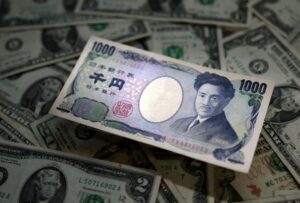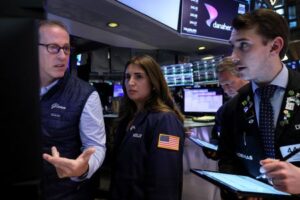By Lucia Mutikani
WASHINGTON (Reuters) – U.S. monthly inflation rose moderately in March, but stubbornly higher costs for housing and utilities suggested the Federal Reserve could keep interest rates elevated for a while.
The report from the Commerce Department on Friday, which also showed strong consumer spending last month, offered some relief to financial markets spooked by worries of stagflation after data on Thursday showed inflation surging and economic growth slowing in the first quarter.
“Markets should breathe a sigh of relief this morning,” said Chris Zaccarelli, chief investment officer at Independent Advisor Alliance. “Given the elevated levels of inflation, and this is the new normal for 2024, the market is going to need to get over hopes for Fed rate cuts.”
The personal consumption expenditures (PCE) price index increased 0.3% last month, matching the unrevised gain in February, the Commerce Department’s Bureau of Economic Analysis said. Goods prices edged up 0.1% as increases in the costs of gasoline, clothing and footwear were partially offset by a decline in prices of motor vehicles and parts.
Services prices rose 0.4%, quickening from February’s 0.3% advance. They were boosted by a 0.5% increase in the cost of housing and utilities, which include rents. Rents have remained sticky even as the supply of apartments has increased and independent measures showed a decline in rent demands.
Economists expect that these lower rents should start showing up in the data at some point this year. Transportation services prices shot up 1.6%, while financial services and insurance were 0.5% more expensive.
In the 12 months through March, inflation rose 2.7% after advancing 2.5% in February. The increase in inflation last month was broadly in line with economists’ expectations.
There had been fears that inflation could exceed forecasts in March after the release of the advance gross domestic product report for the first quarter on Thursday showed price pressures heated up by the most in a year.
The spike in inflation occurred in January. The PCE price index is one of the inflation measures tracked by the U.S. central bank for its 2% target. Monthly inflation readings of 0.2% over time are necessary to bring inflation back to target.
U.S. Treasury prices rose, with the yield on the benchmark 10-year note backing away from a five-month high reached in the previous session. The dollar advanced versus a basket of currencies, while stocks on Wall Street were trading higher.
Fed policymakers are expected to leave rates unchanged next week. The central bank has kept its benchmark overnight interest rate in the 5.25%-5.50% range since July. It has raised the policy rate by 525 basis points since March 2022.
Financial markets initially expected the first rate cut to come in March. That expectation got pushed back to June and then September as data on the labor market and inflation continued to surprise on the upside.
A handful of economists continue to expect that borrowing costs may be lowered in July on the belief that the labor market will slow noticeably in the coming months. Others believe the window for rate cuts is rapidly closing.
“Fed officials will likely not have enough evidence based on inflation data alone to cut rates as soon as June,” said Veronica Clark, an economist at Citigroup. “But we continue to think officials will be increasingly uncomfortable leaving rates at restrictive levels for too long and will find evidence in May and June inflation data to cut rates in July.”
SERVICES INFLATION HOT
Excluding the volatile food and energy components, the PCE price index increased 0.3% in March after rising by the same unrevised margin in February. Core inflation increased 2.8% on a year-on-year basis in March, matching February’s advance.
PCE services inflation excluding energy and housing climbed 0.4% after a 0.2% gain in February. The so-called super core inflation rose 3.5% on a year-on-year basis in March.
Policymakers are monitoring the super core inflation to gauge their progress in fighting inflation.
Consumer spending, which accounts for more than two-thirds of U.S. economic activity, increased by a solid 0.8%, matching the rise in February. The data was included in the GDP report, which showed consumer spending moderating to a still-solid 2.5% pace in the first quarter from the brisk 3.3% pace in the October-December period.
The economy grew at a 1.6% rate last quarter, held back by an increase in the trade deficit. The wider trade gap reflected a surge in imports, a function of strong domestic demand.
Households spent more on both goods and services last month. Goods outlays vaulted 1.3%, with gasoline and other energy products as well as food and beverages, recreational goods and vehicles, and household equipment accounting for the jump.
Services spending rose 0.6%, lifted by healthcare, housing and utilities as well as financial services and insurance.
When adjusted for inflation, consumer spending climbed 0.5%. The so-called real consumer spending also increased 0.5% in February. March’s strong gain put consumer spending on a higher growth path heading into the second quarter.
“Consumers appear to have solid momentum coming out of the first quarter,” said Daniel Silver, an economist at JPMorgan. “While we don’t have much hard data for the second quarter at this point, the end-point for the first quarter suggests that second-quarter spending growth could be strong.”
Personal income increased 0.5% after a 0.3% gain in February, boosted by a 0.7% rise in wages amid a tight labor market. But higher inflation eroded some of the increase.
Disposable household income after accounting for inflation and taxes rebounded 0.2% after slipping 0.1% in February. Consumers saved less and also tapped into savings. The saving rate fell to a 16-month low of 3.2% from 3.6% in February.
“The low saving rate is not a huge concern because we think it mostly reflects the strong state of household balance sheets, with debt-to-income ratios low, the cost of servicing debt still extremely low, and household net worth rising rapidly amid elevated house and equity prices,” said Michael Pearce, deputy chief U.S. economist at Oxford Economics.
(Reporting by Lucia Mutikani; Editing by Chizu Nomiyama and Paul Simao)





